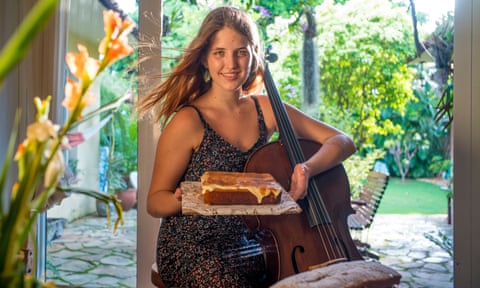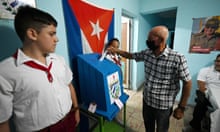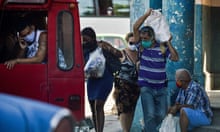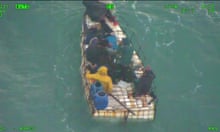Not far from Havana’s Plaza de la Revolucion, where Che Guevara stares out nine storeys high from the side of Cuba’s Ministry of the Interior, Julio Cesar Imperatori perches on the edge of a table in the kitchen of a shuttered restaurant.
“We started to run out of money,” he says of himself and two friends, Osmany and Wilson. “Everyone was closing down. No one was buying pictures. So we decided to do something. We thought, everyone’s gotta eat and my grandmother, Eldia, she has a recipe for pie. And so … the American Pie company.”
Julio is a street photographer. “I opened an exhibition in the Galeria Servando Cabrera in March. Lots of people came to the opening and then, the next day the city was locked down.” He grins. “It must be the longest running show in Cuban history, but nobody’s seen it.”
He disappears and returns with a pie. It is the work of an artist, the vivid orange of mango locked behind latticed bars of pastry as bronzed as a 1970s beach bum. When cut, it oozes. The crust breaks between my teeth and the mango’s richness arrives with the intensity of the Caribbean sun. There are beers on the table and a lot of laughter.
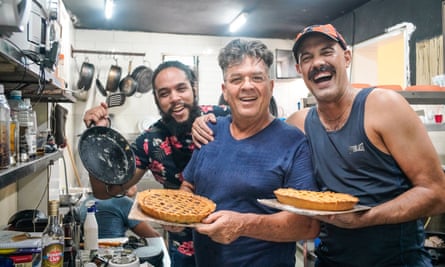
The American Pie Co team with Julio Cesar Imperatori (right).

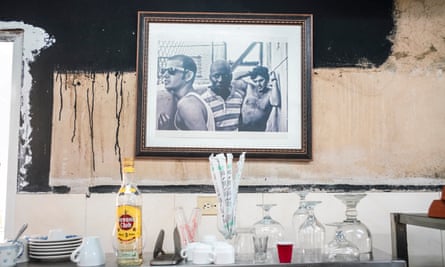
Julio Cesar Imperatori with his grandmother Eldia; a framed photo taken by Julio.
Your name, I say, Julio Cesar Imperatori, it can’t be real. He insists it is. “My great great grandfather came from Italy in the 1860s with his brother, with plans to go on to the US. The brother went, my great great grandfather, stayed. Probably he met a girl…”
The pandemic has been horrible the world over, but in Cuba it came with economic collapse and food shortages; for artists and musicians it proved existential.
Cuba’s borders closed as the virus overwhelmed Florida 90 miles to the north, just as the Trump administration was tightening the 60-year-old blockade of the island and chasing down foreign companies who traded with its communist government.
As the rest of the world cleared their supermarket shelves, Cubans gazed at their long empty ones. Huge queues formed where la bola en la calle – the gossip on the street – told of chicken, pork or cooking oil. Mulos, edgy characters who smuggle in goods on the commercial airlines, now took control of the queues, becoming coleros and offering places for cash, until the army moved them on.
The government, running low on foreign reserves, moved what goods there were to “MLC” (moneda libre convertible, or freely convertible currency) stores which only accept foreign currency, cutting off access to anyone who doesn’t have friends or family abroad. The US then went after Western Union, hindering the flow of dollars from abroad.
Meanwhile Cuban agriculture struggled. The island cannot feed itself. Before the pandemic, it was importing up to 70% of the food it consumes. Fuel shortages and lack of investment mean many farmers still plough with oxen and travel by horse.
As the shortages grew worse, Manuel Sobrino, the minister of food industry, seemed to suggest eating tripe or “decrepit” chicken, but not in the environmentally attuned way you might find recipes for sweetbreads or broiler hens here. No, this wasn’t coming from the same place at all. Nor was the “street food” boom that followed, powered in many cases by Cuba’s artists.
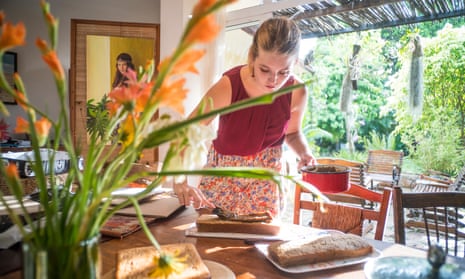
Sarah Sofia Gutierrez in her kitchen.
As the last tourists flew out and the airports closed, Sarah Sofía Gutiérrez was completing her final year at ISA, Havana’s sprawling school of the arts. Although only 22, she has studied music for 17 years and is now a highly regarded cellist. We meet in her parents’ house in the suburbs, drinking coffee in the garden while Pancho, her ageing cat, paws for attention.
“With Covid, everything is distorted,” she says. “At first I was happy, I had so much time to practise, which is actually unusual in the life of a musician. But then, because I still had spare time, I started making cakes.”
Until the end of 2018 Cubans who wanted to get online had to go to wifi parks where the government had installed routers. Then mobile data arrived and everything changed. Sarah discovered social media is good for cakes: “I started to commercialise my Instagram.”
State bakeries traditionally make cakes that are tooth-dissolvingly sweet, using Cuba’s main crop, sugarcane. Yet finding other ingredients can be tricky. The nation’s grocery stores contain poor quality goods, the tat foreign wholesalers palm off (and mark up) for a country weakened by shortages.
Shopping is only really a joy in the street markets, the agro-mercados, which on a good day can be full of the finest fruit. But vendors there are subject to a rickety supply chain – made worse by the pandemic – and the changing seasons.


Sarah making spinach pastry; preparing a cake.
Using these markets and her parents’ garden, Sarah makes cakes with vanilla, coffee, pineapple or chocolate; whatever she can get hold of. She makes brownies and lemon pie. “I thought I would be making two cakes a week and suddenly I had orders for seven a day and I didn’t have eggs any more. I started to freak out.”
She sells her cakes for $8 (about £5.80), in a country where the average salary was, until recently, $40 (about £29) a month. Changes to the currency, including the elimination of the US dollar pegged banknotes, mean Havana’s economy is all smoke and mirrors, with cash coming in from abroad or small private businesses. It turns out enough people have money for her treats.

Dancer and jam-maker Christa Verena Hernandez and her husband Alexis with their children, Leon and Aylin.
It was oversupply that forced dancer Christa Verena Hernandez to start making jams. Christa is Swiss, but lives in the tree-shaded streets of Havana’s Vedado neighbourhood. Wanting to learn salsa and rumba, she had visited the Salson dance school in Zurich, only to fall in love with its Cuban owner, Alexis.
Alexis had been yearning to return home and now they run the Kerida guesthouse, to pay for El Cimarron, a dance school they are setting up across the street. “When the tourists went home, we were left with a fridge full of amazing fruit,” she says. “So I called home and said, ‘Mama, you made jam, how do I do it?’”
As she speaks, her children Leon, five, and 18-month-old Aylin arrive, followed by Alexis. He grew up in Colón, the heart of the sugarcane industry, with a father who didn’t believe men should dance. “I did a lot of boxing,” Alexis says. “But, well, I persevered. Dance is where my soul gets lost.”

Christa and Alexis rehearsing. (right) Christa, Kalia and Niela prepare jams for delivery; decorative covers on the jams.
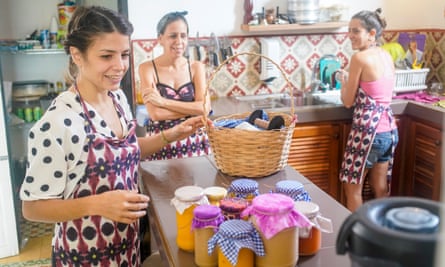

Also sitting with us is Niela Merida Cornejo, an employee of the guesthouse who Christa has made partner in the new business, Los Sabores de la Reina: “I wanted to continue to offer a salary,” Christa says. “And Niela and I wanted to create something new.”
The contents of the fridge were soon turned into jams, lassis and fruitful granolas. Then came the pressure of finding new ingredients. “It’s really difficult,” says Christa. “You have to queue at midnight. Then you get in the store and there is nothing left.
“We also have problems with jars, so we employ someone to find and recycle them. We make bags out of old rice sacks. A neighbour is now sewing them.”
Alexis says he has watched in amazement as Cuba has returned to trueque, the ancient form of barter. “I think people have been standing in front of a mirror and saying, ‘What am I able to do? What can I create?’”
Perhaps the most extraordinary of the artists-turned-chefs is Las Frescas, three film-makers in their mid-20s. Leysa Medina is an actor, Evelyn Batista is a graphic designer and Violena Ampudia is a documentary-maker. If they weren’t so modest they could claim to be changing the way Cuba – or perhaps more accurately Havana – eats.
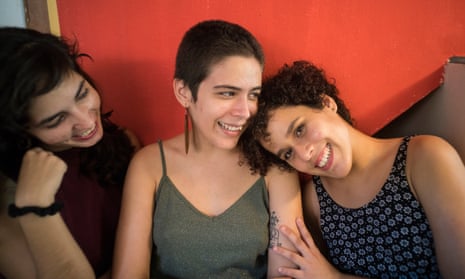
Leysa Medina, Evelyn Batista and Violena Ampudia of Las Frescas.
“We created a space where vegetarian food is made,” says Violena, while outside the window waves off the Straits of Florida explode against the sea wall, Havana’s famed Malecon.
Leysa makes pesto and criolla, a salsa with ginger, garlic, salt and olive oil. Violena makes tahini, hummus, lentil burgers and sesame milk. While these may not sound revolutionary, they are a revelation in Cuba.
“My mother had never tasted pesto,” says Leysa. “And I have a cousin who had no idea about food issues – healthy eating, weight loss, animal welfare – and he’s been discovering this world.”
Evelyn doesn’t cook, but creates the designs that Las Frescas uses on social media. It was her drawings of the three of them, (tastefully) naked, holding vegetables, that initially brought the crowds. Las Frescas not only means the fresh ones in Spanish, it also means the fresh ones.
Their genius though is in having created a co-operative, a brand under which like-minded cooks can shelter. “Our friend Liset is an architect and makes handmade pastries,” says Violena. “Suyín, who works at the film school, makes coconut oil. Denys and Sayli make the aliñao, a drink from Oriente [Cuba’s far east].”
Success came swiftly: “People started writing to us without even knowing that we were selling,” says Evelyn. Leysa says: “A person who follows us said her son has high triglycerides, and asked what could he eat?” She opens her eyes wide: “We are not doctors.”
I try the criolla sauce; it’s delicate, well spiced and in truth, would be brilliant with meat. It’s hard to overstate how counterintuitive vegetarianism is for Cubans. For historical reasons, meat on the table is a matter of honour for many families.
In the early 1990s the economy collapsed following the breakup of the Soviet Union, and the country began to starve. It was what Fidel Castro called the “special period in the time of peace”. That hunger has left a permanent if hidden scar.
Violena says: “When I prepare something for my stepfather, he asks: ‘Don’t you have chicken?’ Then he says in amazement: ‘And people buy this from you? At that price?’”
Salsa Criolla sells for $5 for a jar. While a state ration – including eggs, rice, sugar and beans – is still handed out, top-ups are necessary, and with queues for bread and chicken several blocks long people are growing used to paying more. Faced with handing over three weeks’ salary for a block of industrial gouda, there seems to be an appetite for spending money on better food.
Las Frescas has discovered a deep seam of interest in healthy eating, the way tasty foods can be created out of Cuba’s fruit and vegetables. It would be easy to describe Leysa, Evelyn and Violena as influencers, but they resist it.
“It is very fashionable just now to be an influencer – healthy life and good vibes – but we have been handling the project intuitively,” says Violena. She smiles for a moment, and says: “There’s something you should know. None of us are actually vegetarian.”
Making food, after all, isn’t the primary mission. “We come from art,” says Leysa. “We are very keen on cooking, but I am also very keen on making films.” Which raises the question: when life finally returns to Havana’s streets, what happens next?


Las Frescas’ vegetarian produce; Las Frescas food out for delivery.
All those I spoke to are sure the state, distant during the pandemic, will return. “We’ll have to get a licence, pay taxes,” says Violena. “It could start to feel like a job.”
For Christa the dancer, the choice is simple. She already has the guesthouse. She and Niela will continue to build Los Sabores de la Reina. They’ve already taken on another employee, Kalia, who waves from the kitchen.
Sarah the cellist is certain she will continue to bake. “I love it. As with music, you have to have devotion and patience, you have to be delicate and creative.” She will use the money she earns to study abroad. “Music and cooking are both activities I can live on anywhere.”
Later, I order a cake and Sarah’s mother delivers it. She calls me back as I turn away. She wants to tell me how proud she is of her daughter.
And Julio Cesar Imperatori? I ask about the future while he is showing me a livid scar on his leg, caused when the moped they use to deliver slid on a metal bridge: “The pies ended up in the Almendares [river] with the catfish!”
Julio may not have made it over the Almendares, but he’s crossed the Rubicon. “American Pie is going to be all over the world,” he cries. And why not? The pies are tasty enough, with their fillings of guava, crab, pork, mango, chicken or fish. But it is that perfect crust that really sets them apart.
“My grandmother is very strict about her recipe,” says Julio. “I took her one, which everyone said was amazing, and she goes, ‘Julio, this is a piece of shit.’”
When the laughter subsides, he says: “My grandmother, she’s 93 and I look after her. She needs nappies every day, and she needs a nurse. It’s very expensive.” He quietens further. “But she gave everything to me so I’m going to give her everything she needs.”
